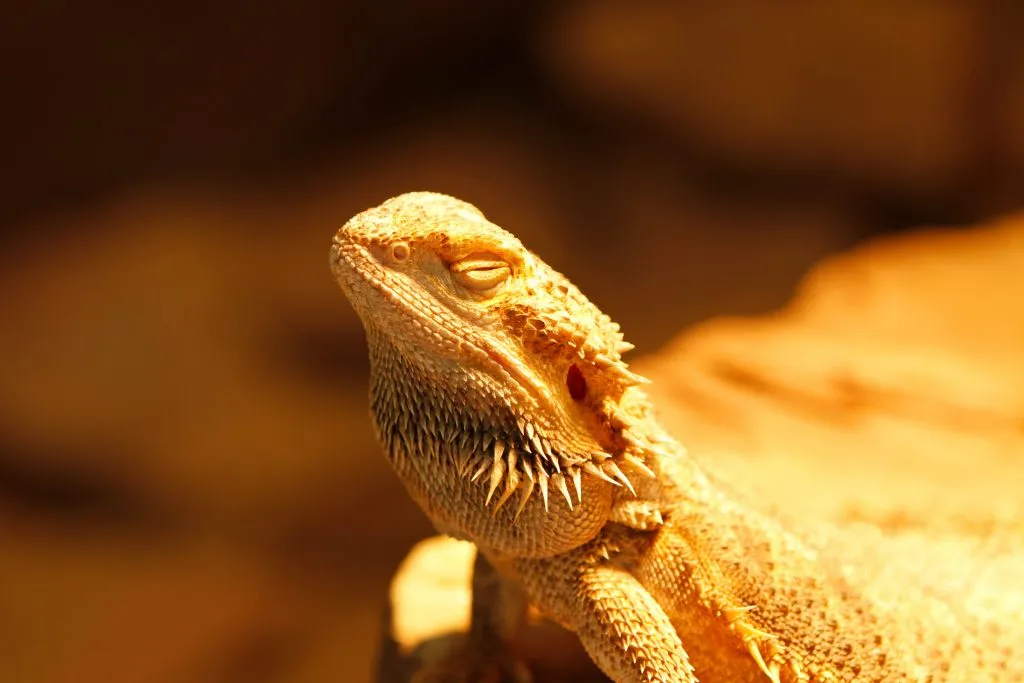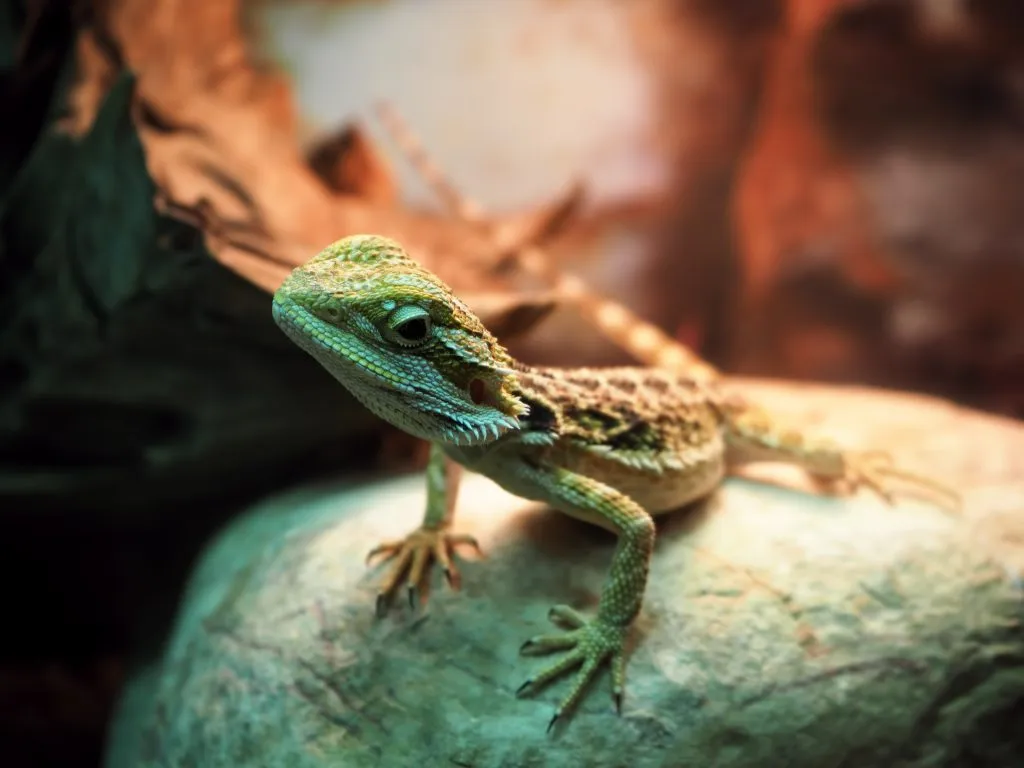
Maybe summer is coming, or maybe you are a worried new bearded dragon owner, but in either case, you are concerned about how to keep your pet at an optimal temperature, and you are wondering if bearded dragons can overheat.
Bearded dragons are cold-blooded reptiles that rely on external sources of heat to regulate their body temperature. Overheating can happen when the temperature and humidity settings of their enclosure are not properly adjusted, which can result in serious health problems and even death.
As a bearded dragon owner, it is important you understand what overheating is and how to prevent it from happening. Keep reading to find out about proper temperature settings for your pet, signs of overheating, and how to help cool down your bearded dragon if it gets too hot.
Table of Contents
How Much Heat Can Bearded Dragons Handle?
Bearded dragons are unable to produce heat on their own; hence, they rely on external sources to warm their bodies and stay at an optimal temperature.
Overheating happens when the beardie’s internal body temperature rises more than it should.
Here is a table that summarizes the ideal temperature conditions for bearded dragons categorized by age group:
| Bearded dragon’s age | Basking area | Cool area |
| Baby | 100-110°F (37.7-43.3°C) | 80-90°F (26.6-32.2°C) |
| Juvenile | 95-100°F (35-37.7°C) | 75-80°F (23.8-26.6°C) |
| Adult | 95-100°F (35-37.7°C) | 75-80°F (23.8-26.6°C) |
Note that these temperatures are specifically for the basking area and cool area, not for the whole enclosure.
During the day, the average air temperature in the whole enclosure should range between 75.2-86°F (24-30°C). At night, the temperature for all age groups should be 70-75°F (21.1-23.8°C).
What Happens When Bearded Dragons Overheat?
Since bearded dragons are highly sensitive to temperature changes, overheating has been proven to be dangerous and detrimental to the health of these reptiles; furthermore, in some cases of extreme heat and when no assistance has been provided on time, it is possible for the beardie to die.
Here is a table that shows some behavioral changes that may occur in bearded dragons depending on the average air temperature they are exposed to:
| Normal | 75.2°F (24°C) – 86°F (30°C) | Normal behavior |
| Mildly high | > 89°F (31.6°C) | Bearded dragons start regulating their body temperature and may not gape as much in order to preserve water to avoid dehydration |
| High | Around 110°F (43.3°C) | Signs of overheating are very clear |
| Very High | > 110°F (43.3°C) | Death may occur |
Signs A Bearded Dragon Is Too Hot

Keep in mind that all the following behaviors can happen for many other reasons besides overheating, but as a rule of thumb, you should always check the
Your bearded dragon will start exhibiting one or more of the following signs when they start overheating:
Gaping
Is not unusual for beardies to gape (keep their mouths open) during the day when they are basking. This is done to release excess heat from their bodies.
However, continuous gaping for prolonged periods of time may be a sign of overheating.
Digging
If you notice your beardie starts digging, it may mean they are trying to burrow themselves since, in the wild, they dig deep holes to reach cooler areas in the ground.
Tip: That’s why heat mats should never be installed under the bearded dragon
tank . More on that here!
Hiding In A Cooler Area
Your beardie may normally spend time in the hiding spot right after they finish basking in order to cool their body; but, if you notice your pet is spending most of its time in the hiding spot, it could mean the temperature is too high, and they are trying to protect themselves from it.
Glass Surfing
Some bearded dragons will start “glass surfing” when they are under stress. This means that they will run along the sides of the enclosure while trying to climb the walls of the
Although glass surfing can happen for many reasons, one of the most common causes is believed to be overheating.
Hoarding The Water Bowl
Staying next to the water bowl and drinking more water than usual may be another sign of overheating.
Heat Stroke In Bearded Dragons
Bearded dragons are sensitive to changes in the environment and therefore are prone to heat stroke, which constitutes a medical emergency.
Heat stroke occurs when a beardie has been exposed to extremely high temperatures for prolonged periods of time. Signs of heat stroke include:
- Rapid breathing
- Lack of energy
- Loss of appetite
- Unresponsiveness
If you confirm the
How To Cool Down A Bearded Dragon

Your beardie has been exhibiting signs of overheating, and after checking the
Remove Your Pet From The Tank
Getting your beardie out of the
Use A Spray Bottle To Mist Your Beardie
This is an easy and fast way to cool down your beardie if they are showing signs of overheating. Just grab a spray bottle and fill it up with chlorine-free water and mist your pet several times per day as necessary.
Provide Clean Drinking Water
If your pet is dehydrated, chances are they will drink fresh water to cool down their bodies.
Raise The Basking Lamp
Raising the basking lamp is a quick and effective method to decrease the
If the temperature is at dangerous levels, you can turn off the lamp manually until you can sort out the issue.
How To Prevent Overheating In Bearded Dragons
When adopting a bearded dragon, you must always make sure to provide an enclosure that closely resembles its natural habitat.
A good enclosure must have a basking area and a cooler area. The basking area is the hottest part of the
Having a basking area and a cooler area in the
Here is a list of the proper settings your
Basking Area
You can use a UV lighting bulb or heating lamp, pointing downwards and placed at only one end of the
The bulb or lamp should be on during the day and off at night, in this case, it may be useful to have a simple plug-in timer that stays 12 hours on during the day and 12 hours off at night.
It is also important to place a natural stone in the basking area so your beardie can get better access to the heat, but place it in a way that your beardie’s back gets no closer than 9.8 inches (25 centimeters) from the lamp. That way, you avoid accidental burns on your pet.
Since bearded dragons sense heat from above, not below, hot rocks with built-in heaters are not recommended because beardies can burn their bellies from lying on them.
Cooler Area

Provide your pet with enough hiding spots in the cooler area of the
Use Both A Thermostat And A Thermometer
A thermostat is a simple device that allows you to regulate the temperature, while a thermometer will let you check the exact temperature of the enclosure.
Thermostats, while handy, may be faulty. Therefore, you should use a thermometer to check the basking area temperature and the cooler area temperature every day.
If you notice the
Provide Adequate Ventilation And Humidity Levels
A hygrometer is a useful tool to measure the humidity in the cooler area of the
Misting the tank and your bearded dragon once or twice a day can help to cool your beardie down.
Higher humidity levels that never go down can mean your beardie can get overheated and even get some skin or breathing problems. If this is the case, make sure to provide more ventilation to dissipate excess heat (and humidity).
- Enchi Ball Python: A Unique and Stunning Morph of Python regius - March 27, 2025
- Emerald Tree Monitor: The Enigmatic Green Guardian of the Rainforest - March 26, 2025
- The Egyptian Cobra (Naja haje): A Fascinating Serpent - March 25, 2025
